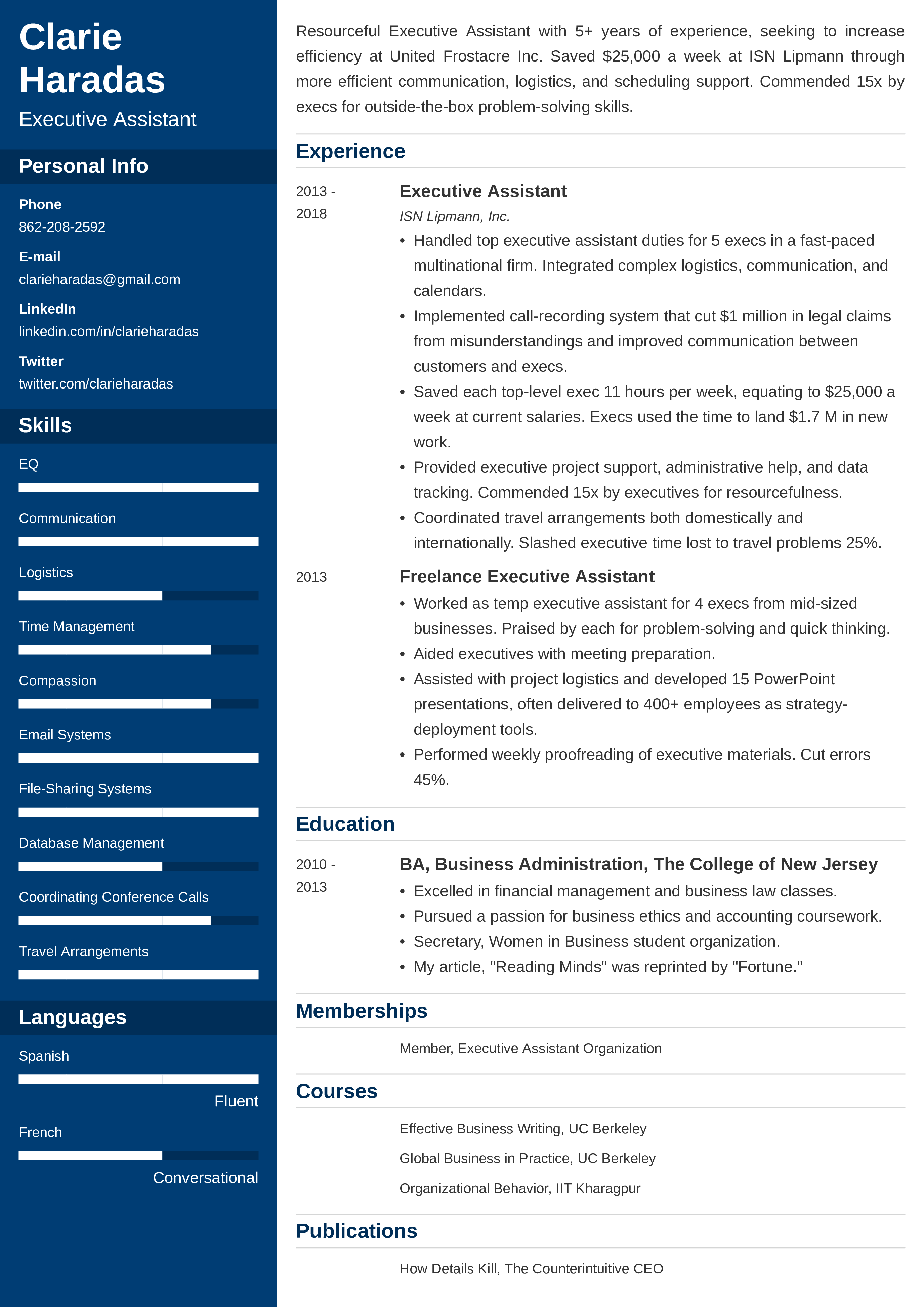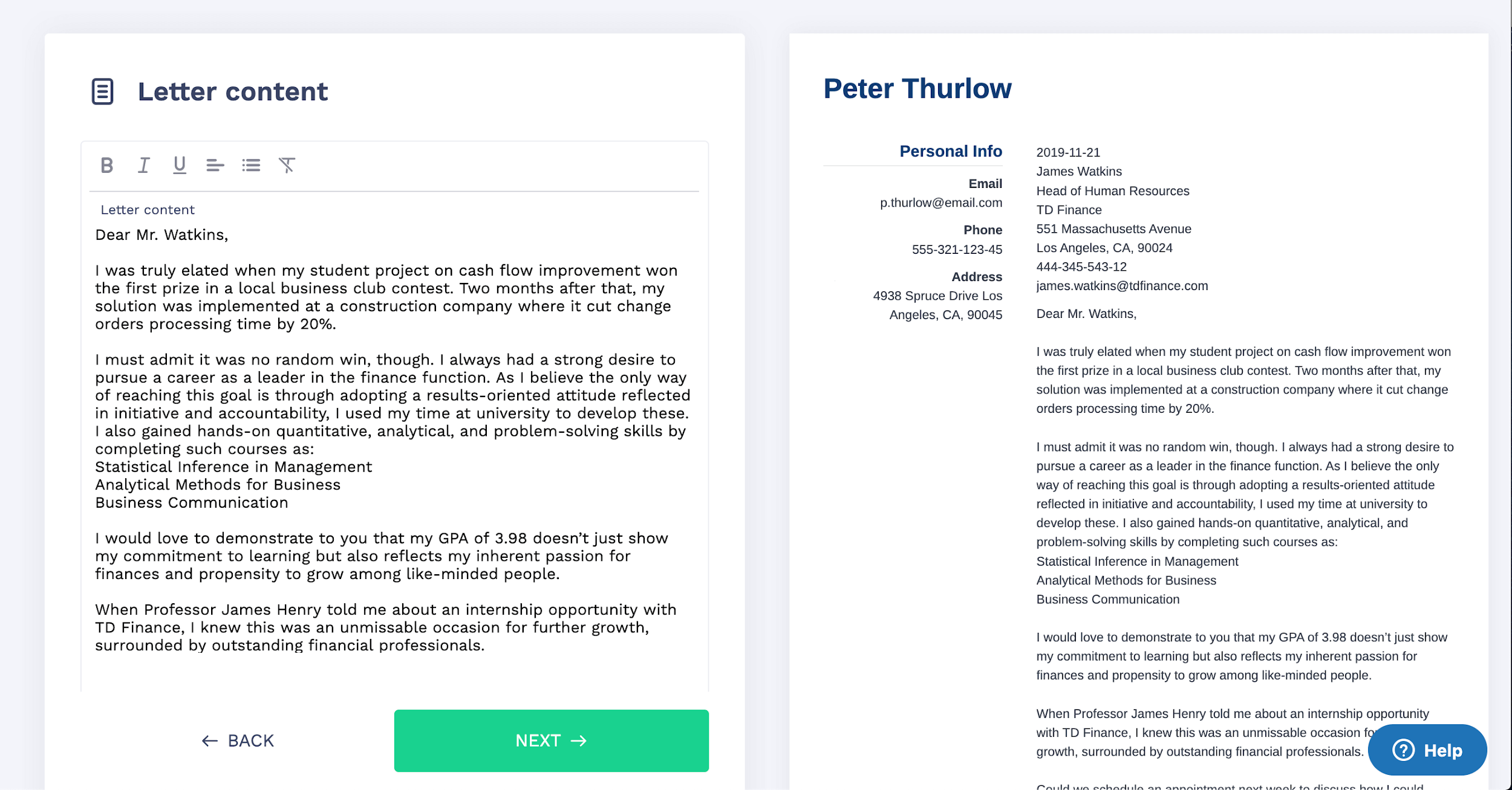
CV for Internship—Sample & 25+ Writing Tips
A CV for internships that’ll get you into the interview. Write your internship CV fast, with expert hints, 25+ writing tips & good and bad examples.

Tom Gerencer
Career Expert
In 5 minutes you'll learn what to put on a CV, but first think about this—You have years of skills, goals, work history, and education. Yet, you’ve only got an 8x11” piece of paper in front of you (or maybe 210×297 mm).
How can you squeeze all that into such a limited space? Which CV sections are a must? Which to leave off? Where do you put what? Well, the first thing to put is your mind at ease.
In this CV guide, you’ll learn:
Save hours of work and get a CV like this. Pick a template, fill it in. Quick and easy. Choose from 21 CV templates and download your CV now.

What users say about ResumeLab:
I had an interview yesterday and the first thing they said on the phone was: “Wow! I love your CV.”
Patrick
I love the variety of templates. Good job guys, keep up the good work!
Dylan
My previous CV was really weak and I used to spend hours adjusting it in Word. Now, I can introduce any changes within minutes. Absolutely wonderful!
George
Expert Hint: When should you use a CV, and when is it better to use a curriculum vitae? It depends. CV and CV actually have a different meaning across languages. Read about the difference between a CV and a Resume.
I know, I know. You learned how to write your name and address back in preschool.
But, before you skip right past this part of a CV, there’re a few important things to know to get your CV contact info right.
Here are which contact details to put in a CV header:
Don’t include personal information like your gender, birthday or marital status in your contact section.
Forget about adding a photograph, too, if you are looking for a job in the US or the UK.
Expert Hint: If you’re adding social media profile links, clean them up! Remove unprofessional content from Facebook, and fix up that LinkedIn profile. Knowing how to make a CV work includes a lot of off-CV parts!
Below your contact info comes your heading statement. That prominent placement means the HR manager’s eyes see it first. (Which means it’s one of the most important sections of a CV.)
Here’s what should be included in a CV profile area:
CV Summary Statement—a short statement providing a summary of your work experience and relevant qualifications (here you can find good examples of summary of qualifications)
CV Objective Statement—a concise paragraph, tailored to the position, stating your career goals and how you want to achieve them at this employer. Also called a CV career objective.
Pick one or the other, as you don’t use both CV headings.
Good CV heading introductions should be around 2-4 sentences in length—a neat, 3- or 4-line paragraph. Use an objective statement when you either have a little or no experience CV related to the job you’re applying for, or when you’re targeting a very specific position. Otherwise, choose the CV professional summary.
Expert Hint: How long should a CV be? Job CVs should be one page for most candidates. Two pages is okay, but just make sure everything on your CV is adding value. Don’t go back more than 10 years in your work history, except when applying for senior positions.
The employment history area is the centrepiece of a CV. It goes just below the CV introductory statement.
However, if you have little to no employment history (no experience CV, university CV, student CV, etc.), this will go under the education section, which we’ll get to shortly.
Here’s what to include in a CV work experience section:
That’s what to include on a CV experience entry. And if you're showing more than one previous workplace, repeat it for the following entries. But, don’t go back more than 10-15 years—they’re not looking for a Walter Isaacson-length biography!
Begin each job description entry with powerful words and action verbs.
Also, add any internships you may have had here to your job experience section, but only if they’re relevant or if you lack work experience.
Expert Hint: Use 4 or 5 bullet points to support each work experience entry. Also, keep the job ad handy as you write your employment history section so you can tailor the contents to what they’re looking for.
nbsp;
The education CV section will usually go just after (below) your work history CV section.
However, if you are a recent graduate, writing an academic CV, or a professional returning to school, bump this section up to just under your CV intro.
Here’s what to include in a CV education section:
If you’ve completed a degree, don’t add your high school diploma. However, if you haven’t, or if you are still in progress, be sure to mention it.
Also, dates may be left off, especially if your years at the institution were 10 years or more in the past.
Expert Hint: GPA is unnecessary on a successful CV. If you’re thinking of adding GPA on CVs, make sure it’s 4.0 or very close to that, or else this will backfire.
The ResumeLab builder is more than looks. Get specific content to boost your chances of getting the job. Add job descriptions, bullet points, and skills. Easy. Improve your CV in our CV builder now.

Nail it all with a splash of colour, choose a clean font, highlight your skills in just a few clicks. You’re the perfect candidate and we’ll prove it. Use the ResumeLab builder now.
Finally, the skills CV section, the last of the must-include CV areas. Add 5-10 relevant CV skills, along with a level of proficiency for each if you so choose.
Here are the best types of skills to put on CVs:
Use work skills and CV qualifications they’re looking for on the job ad to make your own job skills list. Make them as close to the wording from the job ad as possible for the best CV keywords.
Expert Hint: Your arsenal of job-related abilities and skills to put on a CV is called your skill set. Just make sure to only put relevant skills on your CV rather than just a list of skills you know. Everybody and their goldfish adds they’re “proficient in Microsoft Office.”
All those parts of a CV we’ve discussed up until now are the standards.
That means everyone will have them.
If you want to distinguish yourself from the rest, it’s good practise to add some extra CV sections.
Here are the extra CV sections to consider:
Expert Hint: Don’t add the CV references section! You can add a reference page along with your CV, but only if you must.
Here are some other essential items to consider when writing a CV:
Expert Hint: “Should you submit a cover letter?” Well, a cover letter can seriously boost your chances. Our recent study conducted among recruiters, hiring managers, and HR pros shows that 83% of them say a great cover letter can help you land an interview even if your CV isn’t that good.
Double your impact with a matching CV and cover letter combo. Use our cover letter builder and make your application documents pop out.

Want to try a different look? There’s 18 more. A single click will give your document a total makeover. Pick a cover letter template here.
Ways that you can tailor your CV include:
Got any questions on what to put on a CV? Not sure which of the additional CV sections to add? Let’s have a convo about it in the comments below, and, as always, thanks for reading!
At ResumeLab, excellence lies at the heart of our values, underpinning our promise to provide outstanding career resources. Our team of career experts meticulously assesses each article in line with our editorial guidelines, guaranteeing our content's high quality and dependability. We consistently engage in original research, illuminating the nuances of the job market and earning acclaim from various influential news outlets. Our commitment to delivering professional career advice draws millions of readers to our blog annually.

A CV for internships that’ll get you into the interview. Write your internship CV fast, with expert hints, 25+ writing tips & good and bad examples.

Tom Gerencer
Career Expert

Learn how to write a CV for a teenager with no experience, employers will respect. Write your teen CV fast, with tonnes of UK teenage CV samples.

Tom Gerencer
Career Expert

Find out how to send a CV by email and what to write in an email when sending a CV. See a sample email for sending a CV and learn how to write one yourself.

Michael Tomaszewski
Certified Professional Resume Writer, Career Expert